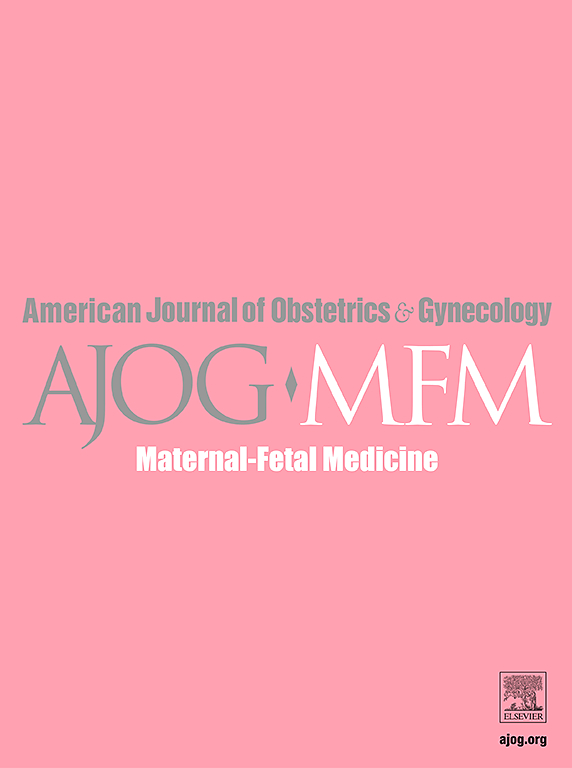Amlodipine versus nifedipine ER for the management of postpartum hypertension: a noninferiority randomized controlled trial
IF 3.8
2区 医学
Q1 OBSTETRICS & GYNECOLOGY
American Journal of Obstetrics & Gynecology Mfm
Pub Date : 2025-01-01
DOI:10.1016/j.ajogmf.2024.101575
引用次数: 0
Abstract
Background
Postpartum hypertension is an increasingly prevalent problem and optimizing its treatment is imperative in reducing maternal morbidity and improving long-term health outcomes. Despite this, data on treatment of postpartum hypertension is limited. While most available studies focus on labetalol and nifedipine ER, these medications are not frequently used for hypertension treatment in the non-obstetric setting. As we aim to establish best practices for managing postpartum hypertension, use of more commonly encountered antihypertensives should be evaluated.
Objective
To evaluate the use of amlodipine for the treatment of postpartum hypertension, as assessed by postpartum length of stay.
Study Design
In a pragmatic, randomized controlled noninferiority trial, patients were assigned to amlodipine or nifedipine ER for treatment of postpartum hypertension. The primary outcome was time from delivery until discharge with a noninferiority limit of 24 hours. A sample size of 132 was needed to achieve 80% power with a 2-tailed alpha of 0.05. Intent-to-Treat and Per Protocol analyses were performed. Prespecified secondary outcomes included the need for additional antihypertensives, side effects, medication discontinuation, breastfeeding satisfaction, and readmission rate. A post-hoc analysis of time from medication initiation until hospital discharge was also performed.
Results
From April 2021 to December 2022, 7618 patients were screened and 175 patients were randomized, with 132 meeting criteria for antihypertensive initiation. Baseline demographics were similar between groups. Amlodipine had a non-inferior length of stay compared to nifedipine ER (Intent-to-Treat Wilcoxon pseudo-median amlodipine=73.5 hours, nifedipine ER=72.0 hours, 95% CI -8.00 to 6.00). The remainder of analyses were performed only on the Per Protocol cohort. Time from medication initiation until hospital discharge was similar between groups (amlodipine=45.0 hours, nifedipine ER=45.5 hours, 95% CI -8.00 to 13.00). There were no differences in use of additional antihypertensives or patient-reported side effects or breastfeeding outcomes, but hypotension and tachycardia were less common with amlodipine use. Amlodipine was significantly less likely to be discontinued due to side effects (amlodipine n=0, nifedipine ER n=7 (10.1%), p=.02). Readmission rates were similar between groups.
Conclusion
Amlodipine is noninferior to nifedipine ER for postpartum hypertension treatment, as defined by median length of postpartum stay. Rates of side effects were similar between groups, but there was a statistically significant difference in medication discontinuation rates.
Clinical trial registration: Clinicaltrials.gov, www.clinicaltrials.gov, NCT04790279
El resumen está disponible en Español al final del artículo.
氨氯地平与硝苯地平ER治疗产后高血压:一项非劣效性随机对照试验。
背景:产后高血压是一个日益普遍的问题,优化其治疗是降低孕产妇发病率和改善长期健康结果的必要条件。尽管如此,产后高血压的治疗数据还是有限的。虽然大多数现有的研究集中在拉贝他洛尔和硝苯地平ER,但这些药物并不经常用于非产科环境中的高血压治疗。由于我们的目标是建立管理产后高血压的最佳做法,应该评估更常见的抗高血压药物的使用。目的:评价氨氯地平对产后高血压的治疗效果,评价其产后住院时间。研究设计:在一项实用的、随机对照的非劣效性试验中,患者被分配到氨氯地平或硝苯地平ER治疗产后高血压。主要观察指标为从分娩到出院的时间,非劣效性限制为24小时。需要132个样本量才能达到80%的功效,双尾α值为0.05。进行意向治疗和每个方案分析。预先指定的次要结局包括需要额外的抗高血压药物、副作用、停药、母乳喂养满意度和再入院率。从开始用药到出院的时间也进行了事后分析。结果:2021年4月至2022年12月,共筛查7618例患者,随机纳入175例,其中132例符合降压起始标准。各组之间的基线人口统计数据相似。与硝苯地平ER相比,氨氯地平的住院时间不低于硝苯地平(意向治疗Wilcoxon伪中位数氨氯地平=73.5小时,硝苯地平ER=72.0小时,95% CI -8.00-6.00)。其余的分析仅在Per协议队列中进行。两组间从开始用药到出院的时间相似(氨氯地平=45.0小时,硝苯地平ER=45.5小时,95% CI -8.00-13.00)。在使用额外的抗高血压药物或患者报告的副作用或母乳喂养结果方面没有差异,但使用氨氯地平时低血压和心动过速较少见。氨氯地平因副作用而停药的可能性显著降低(氨氯地平n=0,硝苯地平ER n=7 (10.1%), p=0.02)。两组再入院率相似。结论:以中位产后停留时间为标准,氨氯地平治疗产后高血压的效果优于硝苯地平。两组之间的副作用发生率相似,但停药率有统计学上的显著差异。临床试验注册:Clinicaltrials.gov, www.Clinicaltrials: gov, NCT04790279。
本文章由计算机程序翻译,如有差异,请以英文原文为准。
求助全文
约1分钟内获得全文
求助全文
来源期刊

American Journal of Obstetrics & Gynecology Mfm
Medicine-Medicine (all)
CiteScore
7.40
自引率
3.20%
发文量
254
审稿时长
40 days
期刊介绍:
The American Journal of Obstetrics and Gynecology (AJOG) is a highly esteemed publication with two companion titles. One of these is the American Journal of Obstetrics and Gynecology Maternal-Fetal Medicine (AJOG MFM), which is dedicated to the latest research in the field of maternal-fetal medicine, specifically concerning high-risk pregnancies. The journal encompasses a wide range of topics, including:
Maternal Complications: It addresses significant studies that have the potential to change clinical practice regarding complications faced by pregnant women.
Fetal Complications: The journal covers prenatal diagnosis, ultrasound, and genetic issues related to the fetus, providing insights into the management and care of fetal health.
Prenatal Care: It discusses the best practices in prenatal care to ensure the health and well-being of both the mother and the unborn child.
Intrapartum Care: It provides guidance on the care provided during the childbirth process, which is critical for the safety of both mother and baby.
Postpartum Issues: The journal also tackles issues that arise after childbirth, focusing on the postpartum period and its implications for maternal health. AJOG MFM serves as a reliable forum for peer-reviewed research, with a preference for randomized trials and meta-analyses. The goal is to equip researchers and clinicians with the most current information and evidence-based strategies to effectively manage high-risk pregnancies and to provide the best possible care for mothers and their unborn children.
 求助内容:
求助内容: 应助结果提醒方式:
应助结果提醒方式:


